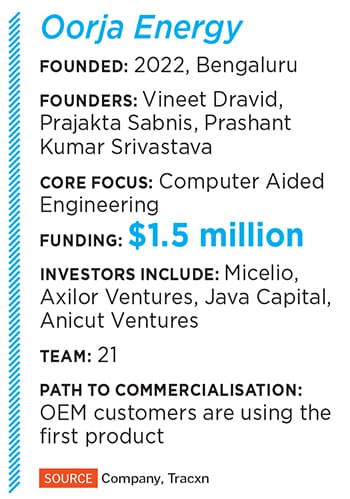How Oorja is mixing physics and data for predictive analysis
Combining physics-based modelling and machine learning, the startup has garnered customers in India, the US and Europe
 Vineet Dravid (front) and Prashant Kumar Srivastava (back), the co-founders at Oorja Energy Image: Nishant Ratnakar for Forbes India
Vineet Dravid (front) and Prashant Kumar Srivastava (back), the co-founders at Oorja Energy Image: Nishant Ratnakar for Forbes India
Vineet Dravid, founder of Oorja Energy, has been in the scientific computing industry his entire adult life, for close to 20 years now. And the idea of building a software product company in the area of computer aided engineering (CAE) came out of that experience.
Worldwide, this is a $15 billion industry. Within that, Dravid’s company is addressing an opportunity: The combination of physics-based modelling and machine learning. His idea is that this will make the models more accurate, faster and cheaper.
 “We want to create the next generation CAE software merging physics with machine learning to reliably and quickly perform predictions on any engineering system,” Dravid says.
“We want to create the next generation CAE software merging physics with machine learning to reliably and quickly perform predictions on any engineering system,” Dravid says.In the long run, the lofty aim at Oorja is to “be the Google for engineering analytics”. But, to begin with, Dravid and his two co-founders have zeroed in on analytics for designing and developing batteries for the EV (electric vehicles) industry.
With batteries costing as much as 50 percent of an EV, predictive analytics that can improve their designs to mitigate the risk of thermal runaway would be extremely valuable to the entire ecosystem of OEMs in the sector.
Dravid won’t take any names, but customers include large OEMs in India and the US and Europe working across domains, four-wheelers, buses, trucks, as well as off-road equipment, he says.
Dravid, Prajakta Sabnis and Prashant Kumar Srivastava started Oorja only in 2022. They’ve raised about $1.5 million in seed capital and put together a team of about 20 engineers so far. Investors include Micelio, Axilor Ventures, Java Capital and Anicut Ventures.
Also read: From Aerostrovilos to Bellatrix Aerospace: Deeptech startups, one year on
“Engineering design is getting more complex and time-consuming, leading to long release cycles,” Alok Chauhan, principal at Micelio Technology Fund, said in a statement when the venture capital firm led Oorja’s seed investment in September 2023. Oorja’s product is “an impactful solution that has the potential to be a global category leader in the space”, Chauhan added.
With each iteration, Oorja will become easier to use, Dravid says. Today, already, customers can simply download an app and start using it. Often the end-users are highly technically qualified engineers, so Oorja allows them to integrate their own code as well, he says.
In the future, a low-code interface might be in the works, where customers can start mixing and matching interfaces and customise Oorja to match their needs.
(This story appears in the 12 July, 2024 issue of Forbes India. To visit our Archives, click here.)


















